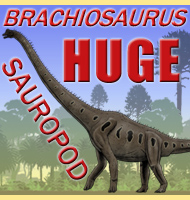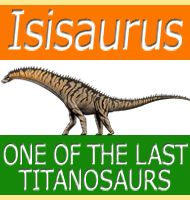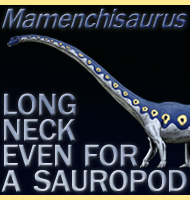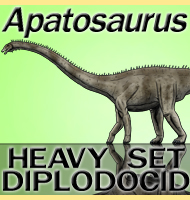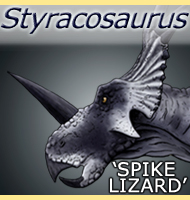


Bruhathkayosaurus
Name:
Bruhathkayosaurus
(Huge bodied lizard).
Phonetic: Bru-hath-kay-o-sore-us.
Named By: P. Yadagiri & K. Ayyasami
- 1989.
Classification: Chordata, Reptilia, Dinosauria,
Saurischia, Sauropoda, Titanosauria?
Species: B. matleyi (type).
Diet: Herbivore.
Size: Uncertain since original fossils are now gone
and estimates vary considerably.
Known locations: India - Kallemedu Formation.
Time period: Early Maastrichtian of the Cretaceous.
Fossil representation: Description based upon hip,
and leg bones, but these are now lost to science and only the
original description and line drawings remain.
Since
it was named in 1989, the dinosaur genus Bruhathkayosaurus
has
attained almost mythical status. The original description of the
bones of this dinosaur were originally interpreted as belonging to a
theropod dinosaur, though later study of the description has led
readers to conclude that the remains were actually of a titanosaurid
sauropod, and an impressively large one at that.
Apparently the
tibia of Bruhathkayosaurus was two meters long,
forty-five
centimetres longer than the tibia of Argentinosaurus
which is confirmed
as one of the largest dinosaurs ever. However there is one major
problem with the fossils of Bruhathkayosaurus:
they no longer exist.
There
are reports that not long after the discovery of the Bruhathkayosaurus
fossils, the fossils were swept away and lost in a monsoon. On top
of this, no diagnostic characteristics were identified or described
in the original description. The only representation for what the
original fossils look like is in the form of line drawings that were
made of them. What this leaves us with is a claim for one of the
largest dinosaurs ever that cannot in anyway be substantiated, making
Bruhathkayosaurus one of the most dubious of all the
dubious genera of
dinosaurs.
This
is not actually the first time that what might have been the biggest
dinosaur ever has had fossils that disappeared. In 1878 the
famous American palaeontologist Edward Drinker Cope named Amphicoelias
based upon the description of unusually large vertebrae and limbs that
bore a resemblance to the fossils of Diplodocus,
but greater in
scale. Somehow, and at the time of writing no one knows how,
these massive fossils have been lost, leaving only detailed drawings
and a written description of the bones. Many still question the
validity of Amphicoelias, with some suggesting
that Cope may have
incorrectly measured the fossils, to other theories. But in
Amphicoelias there is at least a more detailed
description that might
allow for new fossils to be attributed to the genus. The loss can
also be explained as some kind of storage error as a result to of the
huge number of fossils that Cope was dealing with. Remember that Cope
was one of the two main figures of the ‘Bone Wars’ and fossils were
collected and stored in such great amounts that palaeontologists are
still sifting through and cataloguing some of this fossils today,
almost one hundred and fifty years after they were collected.
Back
to Bruhathkayosaurus and things are far more
uncertain. It is not
unknown for fossils to be lost and destroyed by environmental factors
before they can be discovered, but when fossils that are supposed to
represent one of the most ground breaking dinosaur discoveries ever
made, it causes many to question if they ever actually existed.
There has at least been some speculation that incredibly long shin
bones of Bruhathkayosaurus may have actually been
the fossilised
remnants of tree trunks. Because only line drawings of the original
fossils remain, estimates for the size of Bruhathkayosaurus
can vary
wildly, ranging anything from thirty up to forty-five meters long,
or even longer. Thirty to thirty-five meters long would certainly be
plausible given that we know of other sauropods of various that that
could reach that, such as Argentinosaurus, Supersaurus
and
Diplodocus. Beyond this though and fossils are
certainly required
before other people will believe how big something was.
Further reading
- A carnosaurian dinosaur from the Kallamedu Formation
(Maestrichtian horizon), Tamilnadu. - P. Yadagiri &
K. Ayyasami - 1989. - In Symposium on Three Decades of
Development in Palaeontology and Stratigraphy in India. Volume 1.
Precambrian to Mesozoic. Geological Society of India Special
Publication, 11(1): 523-528. - In M.V.A. Sastry, V.V.
Sastry, C.G.K. Ramanujam, H.M. Kapoor, B.R. Jagannatha
Rao, P.P. Satsangi, and U.B. Mathur (eds.) - 1989.
- The lost titan of Cauvery. - Geology Today. 38 (3): 112–116. - Saurabh Pal & Krishnan Ayyasami - 2022.
----------------------------------------------------------------------------
Random favourites
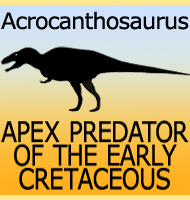 |
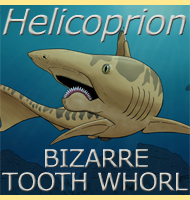 |
 |
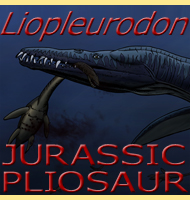 |
